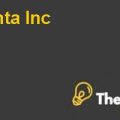Amazonite Enterprises Case Study Solution
Selection of accounts:
The seven accounts that have chosen from the trial balance of Amazonite Enterprise are cash at bank, accounts receivables, inventories, sales, and cost of sales, Depreciation and wages. See Exhibit 1
Materiality:
Auditor sets the materiality by benchmarking certain accounts balances. Normally they benchmark PBIT or sales revenue for income statement and total or non-current assets for balance sheet. Amount of income statement above the 10% of PBIT or 2% of sales revenue is considered as material and amount more than 5% of Total assets is consider as material for balance sheet. While the amount lower than 5% of PBIT, 1% of sales revenue and 2% of Total assets is considered as immaterial. Auditor use judgmental approach to determine the materiality of account balances which are in between of these benchmarks. (evidence, 2016)
We use PBIT as benchmark for income statement items and total assets for balance sheet items. See Exhibit 2
Cash at bank:
Analytical review:
The cash balance at bank of Amazonite have been increased by almost 5.63%, as cash is a liquid asset therefore the risk of theft is high in this account balance. Due to the inherent risky nature of cash the sensitivity of this account has been increased therefore auditor should investigate this account more carefully.(audit, 2016)
Rational for selection:
The cash account is above the materiality threshold. Furthermore, cash has inherent risk as explained above therefore selected for further audit testing. Moreover, there will be very adverse consequences of misstatement in this account as many fraudulent activities can beconduct using this account like theft, money laundering and etc.
Assertion:
The assertion of completeness appears to be reasonable for the cash balance at bank. This assertion states that the all transactions that should have to record in the financial statements are recorded by the management and the cash balance should not have to be over or understated.(assessment, 2016)
Audit Procedures:
- Obtain direct conformation from bank regarding the account balance to ensure that all the transactions have been recorded.
- Review the list of transactions and compare them to the bank statement to ensure the completeness of the cash balance.
Accounts receivable:
Analytical review:
There is a high increment in the accounts receivables as compare to the previous year, they have been increased by almost 18.66%. Although there are many legitimate reasons for the increase in accounts receivables such as increase in sales and change in company’s policy. However, some large discrepancies have occurred in the accounts receivables in many companies and there are many complexities involved regarding the calculation of bad debts which makes this account complex and risky thus, further testing needs to be performed.
Rational for selection:
The accounts receivable balance requires many assumptions and judgements from management regarding the bad debts estimates. The management can alter the assumptions and judgements depending on the needs to improve the financial results of the company. Thus, the risk of material misstatement is very high in this regard.
Assertion:
The relevant assertion for the accounts receivable account is classification, according to this assertion all the transactions should be recorded in their correct account. Accounts receivable amounts should be recorded in accounts receivable accounts and bad debts amount should be recorded in bad debt account.
Audit Procedure:
- Obtain receivable journal ledger and compare the amount of each debtor against the individual debtor ledger to ensure that receivables are recorded at their correct amount.
Inventory:
Analytical review:
Same as accounts receivables the inventory has been increased by 17.82% which can be consider as high. Furthermore, due to the calculation of NRV and various adjustments to inventory like judgments about damages and obsolesce the risk of material misstatement is increased.
Rational for selection:
There is a drastic increase in the inventory level in 2016 as compare with 2015. Furthermore, complexities in determining the value of inventory which requires substantial judgements of management makes this area inherently risky. Along with this inventory account is above the materiality level thus to provide reasonable basis for verification of this account we chose this account.
Assertion:
The appropriate assertion for inventory is accuracy, as per this assertion the inventory should have to be accurately valued and the inventory valuation should be free from any error and the physical inventory count should have to be accurately recorded as well.
Audit Procedures:
- Conduct a physical inventory count at Amazonite to ensure the accuracy of the inventory valuation.
- Check the physical condition of inventory to ensure any damaged inventory is recorded at its NRV.
Sales:
Analytical review:
Some extreme increment in sales have been seen i.e. an increment of approximately 30.03%, companies may record fictitious revenues to report a good performance and to increase the profitability of the company.There are many reasons due to which the management can increase the sales revenue wrongfully such as their own rewards and bonuses.Due to these reasons there is a significant risk of material misstatement in this account................
This is just a sample partial work. Please place the order on the website to get your own originally done case solution.










